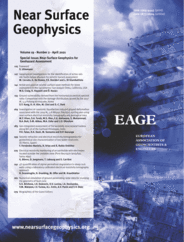
Full text loading...
 , Ivan O. Dubrovin2, Oksana V. Lunina3, Ivan A. Denisenko3, Victor M. Matasov4,5, Irina V. Turova6, Andrey L. Entin1,5, Andrey V. Panin1, Evgeny V. Deev1,6,7
, Ivan O. Dubrovin2, Oksana V. Lunina3, Ivan A. Denisenko3, Victor M. Matasov4,5, Irina V. Turova6, Andrey L. Entin1,5, Andrey V. Panin1, Evgeny V. Deev1,6,7
Palaeoseismology studies the footprints of ancient earthquakes to improve the knowledge about the modern seismicity of the territory. A ground‐penetrating radar (GPR), among other geophysical methods, is used for quick determination of shallow stratigraphy – displaced, oblique layers within the fault zone. GPR data interpretation from diverse and complex reflection patterns of the fault zone heavily depends on the interpreter's experience. The range of different fault zone parameters in which this method can be successfully applied has not yet been investigated. We used a numerical simulation of GPR data to determine how GPR images the elements of faults (fault plane, hanging wall, footwall) in comparison with other reflections. Furthermore, we studied which parameters have the most significant impact on GPR wave patterns. We performed a series of numerical models of a fault, changing its geometry with increasing complexity from elementary models to realistic ones. The resulting synthetic profiles allowed finding specific GPR signatures from the fault plane, the hanging wall and the footwall. We collected field GPR data from two different fault zones and examined them for verification.

Article metrics loading...

Full text loading...
References


Data & Media loading...

